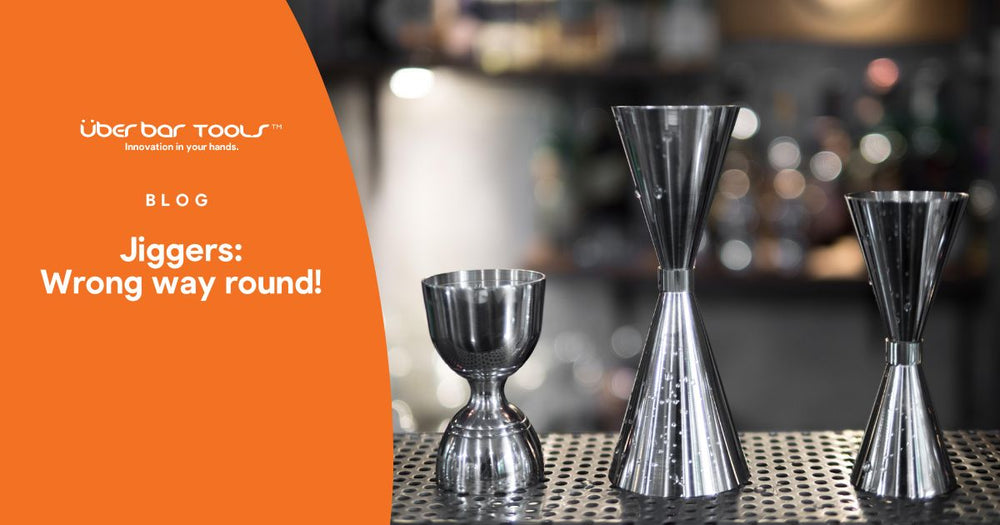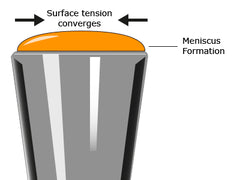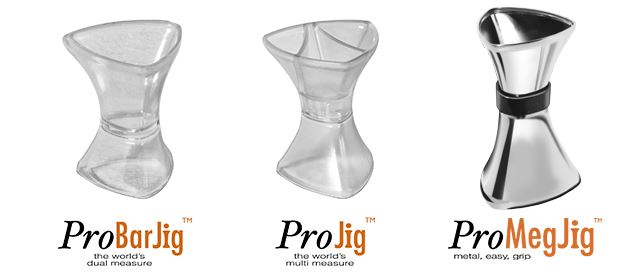
Jiggers or measures are used to portion control alcohol for consistency, compliance and long-term profitability. They became a staple in every bartender kit, bar and hospitality business for these very reasons.
Now, here’s an interesting question: Why are jiggers round? Could it be that our design ancestors may have got it the wrong way round?
Let’s take a look.
Why round jiggers?
- History
Context and habit suggest that's the way it’s always been and therefore mandates the now and near future. For example, we recognise today a spoon as a spoon, a saw as a saw because of history going back thousands of years. Humans love certainty and predictability! - It's always worked, sort of...
Over the last 20 years, there have been some improvements in materials and minor design tweaks, yet jiggers are still much the same thing. So if it isn’t broke, don’t fix it, right? - Why change?
For change to occur, there must be a compelling reason to think differently, making people want to move to better.
The science and math behind round jiggers
 Round jiggers, when filled to the brim, create a lens or dome called a meniscus. There’s no magic to why this happens, it’s simply physics or surface tension. The meniscus adds approximately 10-15% more to a measured liquid's total volume, over and above the designated volume marking shown on the side of the jigger, for example 30 mL or 1 Oz.
Round jiggers, when filled to the brim, create a lens or dome called a meniscus. There’s no magic to why this happens, it’s simply physics or surface tension. The meniscus adds approximately 10-15% more to a measured liquid's total volume, over and above the designated volume marking shown on the side of the jigger, for example 30 mL or 1 Oz.
Here are some internationally popular volume serves, with the arising meniscus consequences:
|
Europe |
20 mL plus 10-15% 2 - 3 mL |
|
UK |
25 mL plus 10-15% 2.5 - 3.75 mL |
|
Australia / New Zealand / Asia |
30 mL plus 10-15% 3 - 4.5 mL |
|
US / Canada |
1 Oz plus 10-15% 1/10 - 1/6 Oz (approx) |
Now we know what the meniscus looks like, so how can we measure it?
First, you’ll need a volumetric scale. We used a scale accurate to 1/1000 of 1 mL or 1/333 of 1 Oz. If you have scales with a digital read out and tare facility, then you too should be able to replicate the results—email us at sales@uberbartools.com to ask for the testing process.
In the first illustration, we have used a standard 30 mL egg cup jigger to test as it happens to be see through and easier to see the meniscus and arising issues, however, as all jiggers are round, it really makes no difference as to which one you use. If you try this test on a number of different jiggers, you’ll be surprised by the massive range of volume variations!

The first illustration shows a 30 mL /1 Oz jigger on the LHS with the meniscus formed at the top. Note: mL and Oz are almost identical, 30 mL = 29.57 (1 US fluid Oz).
Note the RHS picture showing the same filled jigger pictured standing further back so we can see the digital read out. The numbers reflect the weight of the liquid inclusive of the meniscus with the actual weight of the plastic jigger zeroed out. 1 mL =1g in volume is the same in volumetric weight. In the case above, 34.6 mL = 34.6g.
Now, to work out the weight or volume of the meniscus, in this case, 4.6 mL deduct the read out from the designated volume shown on the side of the jigger (34.6 - 30.0 mL = 4.6 mL).
To work out what the percentage over-serve “measure” is, divide the over-served volume amount and divide by the designated volume, for example, 4.6mL /30 mL to get a figure of 15.33% over-serve.
The same story would play out percentage wise if we used a 1 Oz, 20 mL, 25 mL or 2 Oz jigger.
The aftermath of round jiggers
Based on figures of 10-15% over-serve on almost every jigger pour, it’s not very hard to see the cumulative cost to a bar or restaurant business.
Not only that, should that 4mL over serve be spilt in front of a guest say onto a counter top, a bartender is obligated to tip more liquor directly into a vessel to compensate a guest.
A 3-second timed traditional pour dispenses 30mL of liquid and an additional bottle tilt of say 0.5-1 second will then add approximately 5-10mL extra into a guests drink... given away free!
Another example of what the cost to a business is of the over-served meniscus, let’s do some more math:
Say a bar sells 5 cases of spirits a week, equivalent to 60 bottles of 700 mL spirits, and assuming a shot of alcohol contains 30 mL. 1 bottle contains 700 mL of alcohol divided by 30 mL (the volume of 1 shot) to calculate the max amount of shots can be served from one bottle—the answer, 23.33 serves.
60 bottles X 23.33 serves = 1400 shots maximum can be served
So what’s the loss per week/pa:
A 10% meniscus loss equals 140 shots lost (1400 X 10%), 7280/pa (x52).
A 15% meniscus loss equals 210 shots lost (1400 x 15%), 10920/pa (x52).
So whilst history is cool, round jiggers we can see are somewhat of an anomaly.
Jigger innovation
Now with these information, what can we do?
- Buy automated dispensing machines which are expensive, ugly, space consuming and prone to issues.
- Do nothing, ignore the problem and loose substantial amounts 365 days a year, staying with the status quo.
- Change the shape of jiggers.
Point #3 co-incidentally was the thought process that led Uberbartools to design its patented trilobal jiggers the ProBarJig™, ProJig™, and ProMegJig™.
Based on what we now know with science and the needs to save money and generate profits, it appears that when it comes to round jiggers, we need a change. Check out our trilobal jiggers collection.
Read our blog, "How the Jiggers took a U-Turn", as we explore more prevailing challenges and issues around jiggers and the innovations we pursued to address them.


